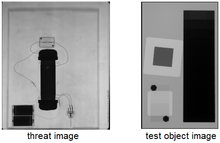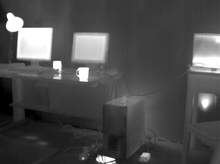Summary
Emergency response, law enforcement and military personnel must face threats and dangerous situations as part of their jobs. These threats can vary from knives concealed under clothing, to explosives hidden in backpacks, to hostile armored fighting vehicles. A variety of sensing and imaging technology exists to detect these threats and provide critical life-saving information. The Security Technologies Group develops the measurement science to support the innovation, advancement, and deployment of the sensing and imaging technology used in security applications.
Description
Threats to personal and collective safety abound in our society. The Security Technologies Group (STG) performs research to advance the technology and measurement science of security imaging and sensing. This work includes the establishment of test and evaluation tools, reference test beds, test artifacts, and documentary standards through leadership in standardization bodies. The STG currently has detection projects in x-ray imaging, infrared imaging, millimeter-wave and microwave imaging, through-barrier radar sensing and imaging, and metal detection.
Testing and evaluation (T&E) of security imaging and sensing equipment is often performed using actual threat objects using typical operational scenarios. This operational threat-based T&E provides estimates of the probability of detecting particular threat objects in particular scenarios at specific times. While valuable, the accuracy, reproducibility, and practicality of such testing is limited by several factors: variability in the skill level and training of human operators; threats are constantly evolving and vary from place to place; threat-based testing is sometimes dangerous (e.g. when working with explosives and flammables). Furthermore, threat-based statistical estimates often require the collection of large amounts of data, at considerable expense.
An alternate approach to T&E is objective laboratory-based testing which can provide rigorous, accurate, and reproducible measures of system performance. Lab-based testing supports product development and technology advancement by providing accurate information upon which changes in hardware and software can be assessed, supports product comparison and selection by providing a common set of performance metrics and test methods, and supports site acceptance and continual assessment of procured products by providing tools for periodic and routine assessment. Lab-based objective testing is often standardized in documentary performance

standards, with associated test methods and sometimes minimally-acceptable performance guidance. Such standards are beneficial to the stakeholder community in several ways: most importantly, they provide a common language for communication and comparison; they can also reduce the need for threat-based testing, thereby speeding up the T&E process and reducing its cost; and for organizations with limited T&E capabilities, standardized minimally-acceptable performance guidance can be extremely valuable when procuring new equipment.
X-ray imaging is used is used throughout the country by law enforcement officers, at the borders, in the military and in transportation security to detect concealed objects, including threats and contraband. Perhaps the most prevalent use of security and safety imaging is made in aviation security. In US airports alone, millions of bags are scanned every week using x-ray systems. Domestic bomb squads and military explosive ordinance disposal teams also use x-ray imaging as a key tool in their efforts to identify explosive devices and render them safe. The NIST Security Technologies Group conducts research and develops standards and metrological tools to assist these stakeholders as they continue to use x-ray imaging technology for security purposes.
Through-barrier sensing and imaging provides the ability to see through nonmetallic optically opaque barriers, such as walls or rubble, for locating and tracking of people and imaging of behind-barrier scenes, and can be achieved using radar-based systems. Applications and users of through-barrier radar include law enforcement, military, and emergency response. NIST is conducting research in through-barrier radar to advance the metrology associated with this technology that will ultimately lead to the development of performance standards. Through collaboration with industry and the user community, NIST is identifying the critical parameters which may be used to quantify the performance of through-barrier radar systems. NIST operates laboratory-based through-barrier radar detection and imaging systems to develop test methods and test objects to measure these critical parameters. Additionally, NIST is developing a library of sample walls that are representative of commercial/industrial and residential construction for use in through-barrier radar testing and measurement.
Metal detection is the most commonly-used technology for finding metallic threats concealed on people. Hand-held metal detectors (HHMDs) and walk-through metal detectors (WTMDs) are common at almost all security checkpoints worldwide. Other types of metal detectors deployed in security applications include hand-worn metal detectors, that are donned similarly to gloves or strapped to the palm, and ground search devices, similar in operation to treasure-seeking metal detectors but designed specifically to find items related to threat objects.

Infrared and millimeter-wave imaging systems are commonly used in firefighting, military vehicle detection, and people screening. The STG has a long term interest in conducting research and developing metrology in these wavelength ranges. We have developed a state-of-the-art passive millimeter-wave imaging system based on cryoelectronic sensor arrays and have the ability to produce physics-based, simulated passive images from the near IR through to the millimeter wave. The STG has also conducted studies testing how effectively firefighters can detect fire hazards as a function of image quality. The STG has also made key contributions to the development of a new image quality standard for active millimeter wave personnel imaging systems, such as those used in U.S. airports (ANSI N42.59).
Artificial intelligence is increasingly used throughout security imaging. Traditionally, the images and videos produced by security imaging systems were evaluated for threats, contraband or other anomalies by trained human operators. As more and more imaging technology is deployed, and with legislative goals of 100 % screening of all baggage, cargo, and airline passengers, automatic threat (or target) recognition (ATR) algorithms are increasingly replacing human operators. The STG has a general interest in the metrology of such detection algorithms. Many state-of-the-art detection algorithms currently rely on deep convolution neural networks (CNNs), and given the critical applications in which they are deployed, it is important to understand how robust these algorithms are to variations in content and quality and to identify the conditions in which they may fail. We have developed state-of-the-art ATR algorithms using deep-learning-based CNN architectures that show excellent threat recognition performance. We have also investigated the robustness of these algorithms to changes in image quality, as well as strategies to lessen their brittleness. Additionally, we are currently developing real-time tools to detect when the images passed to the ATR have significantly different image quality from the training set.

